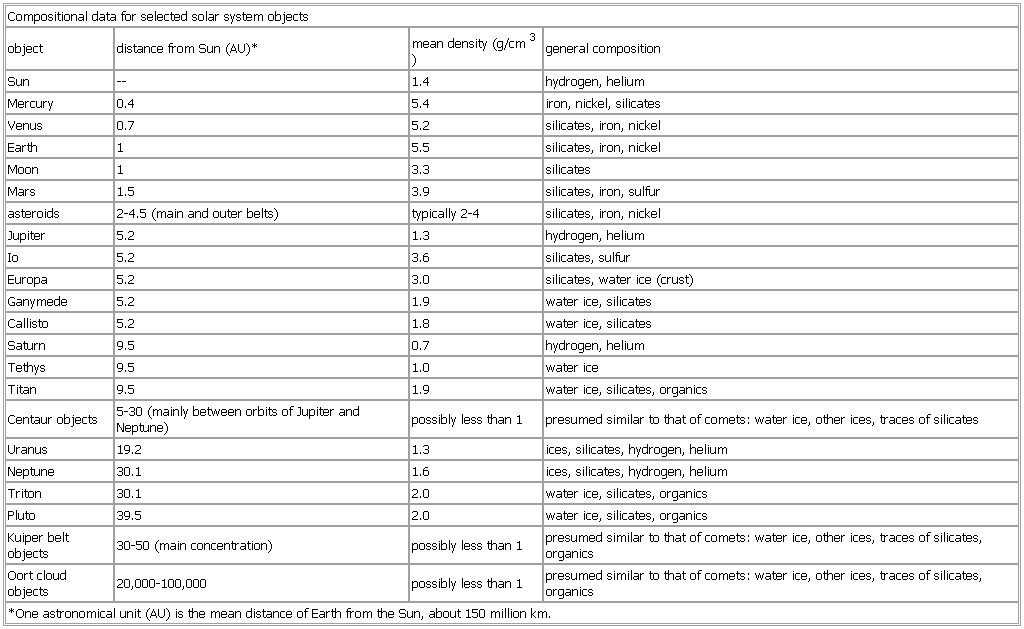Compositional data for selected solar system objects
Table
Compositional data for selected solar system objects
object distance from Sun (AU)* mean density (g/cm3) general composition
Sun -- 1.4 hydrogen, helium
Mercury 0.4 5.4 iron, nickel, silicates
Venus 0.7 5.2 silicates, iron, nickel
Earth 1 5.5 silicates, iron, nickel
Moon 1 3.3 silicates
Mars 1.5 3.9 silicates, iron, sulfur
asteroids (asteroid) 2-4.5 (main and outer belts) typically 2-4 silicates, iron, nickel
Jupiter 5.2 1.3 hydrogen, helium
Io 5.2 3.6 silicates, sulfur
Europa 5.2 3.0 silicates, water ice (crust)
Ganymede 5.2 1.9 water ice, silicates
Callisto 5.2 1.8 water ice, silicates
Saturn 9.5 0.7 hydrogen, helium
Tethys 9.5 1.0 water ice
Titan 9.5 1.9 water ice, silicates, organics
Centaur objects (Centaur object) 5-30 (mainly between orbits of Jupiter and Neptune) possibly less than 1 presumed similar to that of comets: water ice, other ices, traces of silicates
Uranus 19.2 1.3 ices, silicates, hydrogen, helium
Neptune 30.1 1.6 ices, silicates, hydrogen, helium
Triton 30.1 2.0 water ice, silicates, organics
Pluto 39.5 2.0 water ice, silicates, organics
Kuiper belt objects 30-50 (main concentration) possibly less than 1 presumed similar to that of comets: water ice, other ices, traces of silicates, organics
Oort cloud objects 20,000-100,000 possibly less than 1 presumed similar to that of comets: water ice, other ices, traces of silicates, organics
*One astronomical unit (AU) is the mean distance of Earth from the Sun, about 150 million km.
See as table:

- Alexander Kohut
- Alexander Lange Kielland
- Alexander Lernet-Holenia
- Alexander Mackenzie
- Alexander McGillivray
- Alexander McLachlan
- Alexander, Meena
- Alexander Meissner
- Alexander M Lippisch
- Alexander Monro, primus
- Alexander Monro, secundus
- Alexander Montgomerie
- Alexander Morris
- Alexander Natalis
- Alexander Neckam
- Alexander Nevsky, Saint
- Alexander Nowell
- Alexander Of Aphrodisias
- Alexander Of Hales
- Alexander Of Pherae
- Alexander Parkes
- Alexander Parris
- Alexander Pearce Higgins
- Alexander Placide
- Alexander Polyhistor